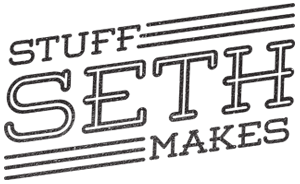This post may contain affiliate links. As an Amazon Associate I earn from qualifying purchases and any earnings made through these links helps me to be able to continue creating content like this. I appreciate you purchasing items through my Amazon links!
I’ve been meaning to build a bigger crosscut sled for my tablesaw for a long time. I have a small sled that I made a while back, but it was sort of a quick and dirty build and has developed a little wiggle. That means the runners under the sled aren’t as snug as they should be, which can result in cuts being less accurate than they could be. That sled is also too small for a lot of projects so it was time for a shop upgrade. Here are a couple photos of my old sled and my hand for reference so you can see the size. I also marked it up for a previous project. Now it’s ugly, haha!
.jpg)
.jpg)
I’m not going to go into much detail about the build of the new sled since it’s a very basic design covered in a lot of other YouTube videos (see my links at the end of the entry). I did however add some spare Rockler T-track and hold downs I had and this allows me to keep the material safely in place while making cuts.
.jpg)
.jpg)
.jpg)
You may also notice I cut the track about a couple inches short. The reason for this is so that there’s still a little room to insert a hold down or other accessory. If I cut the tracks to fit exactly, I wouldn’t have been able to get the hold downs in there!
.jpg)
Instead of this being a “how to build a woodworking crosscut sled” article, it’s more of a “here’s a couple ways how I use my new crosscut sled” article. I’m currently in the middle of building a couple Zelo Side Tables, and by building a larger crosscut sled I’m able to ensure that the back of the leg is square to the feet so once the table is complete it will sit flat on the ground. With this sled it’s also easier to get an identical distance from the crotch of the table leg to the end of the feet. I achieve this using a little piece of scrap wood. I cut a radius/profile on the scrap wood that matches the crotch of the table leg.
.jpg)
Next I can line up how much material I want to remove from the feet, put my stop block in the crotch and secure it in place with one of the hold downs. Now I can make my cut, then remove the workpiece and simply slide the next one into position and I know the cut will be exactly the same every time over and over.
.gif)
.gif)
Now that I have the feet squared up to the leg, I need to cut the whole leg to it’s final length. This crosscut sled is big, but it’s not massive and the legs are still a little longer than the sled itself. Since I can’t use the stopblock on the sled itself, I use the fence of the tablesaw to get my final length. I figure out the length I want and move the fence to that mark. Then I take a piece of scrap wood, in this case I know the scrap piece is 1/2″ thick, and clamp it to the tablesaw fence (any appropriate size clamp will do, but I like these Jorgensen Quick Clamps) and then move the fence over to the right another 1/2″ to compensate for the 1/2″ piece of scrap wood. This piece of scrap wood has now become my stopblock.
.jpg)
.jpg)
Now when I put my table leg against the sled fence, I can slide it over until the foot hits the scrap wood I just clamped to the tablesaw fence. When I make my cut, the the scrap wood piece stays put while the table leg moves forward away from it, and now the feet are not sliding against any surface that could possibly cause friction or binding resulting in a messed up cut or even injury to myself. The tablesaw fence is pretty smooth and the chances of the workpiece binding are probably pretty slim but why risk it? Call me old fashioned but making repeatable cuts safely is cool to me, haha!
.gif)
.gif)
So there you have it. Me, using my new diy crosscut sled. Obviously, cutting these walnut table legs like this is not the only thing to do with this crosscut sled, it’s just what I happened to be working on at the moment and wanted to share it with you! I’m looking forward to making tons of other cuts and finding other interesting and creative ways to clamp down various parts and jigs and whatever else a unique scenario may call for.
*Just Added*
I was just about to wrap up this post but then another unique opportunity presented itself to use the sled creatively. A few days ago I needed to make some picture frames for some rustic wood art my wife made.
.jpg)
I made the frames with mitered corners but the frames I made were fairly slim and modern in style and I felt they could benefit from some extra structural strength in the form of splines added to the mitered corners so I whipped up a quick spline jig to use with the crosscut sled.
.jpg)
Making this particular spline jig took a couple minutes to brainstorm and about 10 minutes to make. I simply used some scrap plywood I had in the shop, and threw it together using some glue and brad nails. As you can see from the photos, I made the bottom piece capable of being tightened down using the hold downs in the t-track. You just set the blade height based on your frame corner (making sure the height of the blade won’t cut through to the inside of the frame unless you want to make extra work for yourself later) and then set the spline jig in the sled the distance away from the blade that you want the spline to be away from the face of the picture frame (does that make sense?). When you’re positioned, just tighten the hold downs. Now you can bring your picture frame onto the jig and I like to clamp the frame to the jig to make sure it doesn’t go anywhere.
.jpg)
.jpg)
.jpg)
.jpg)
Make the cut, and repeat on the other corners. For these particular frames I did 2 splines on each corner. Once I cut the first set of slots, I just flipped the frame over and repeated the process. Now I had 2 spline slots on each corner, the same distance from the front and rear faces of the picture frames. To finish everything off, I ripped some thin strips of the same wood (which in this case was red oak) then cut little triangles and glue them in place. Once the glue dried I cut off the excess with my flush cut saw, sanded it smooth and that was that!
.jpg)
I apologize for not having a better photo of the splines. Adding the spline jig info to this blog entry was sort of an afterthought and this rustic wood art order was already on it’s way to it’s new home in Tennessee! But you’ll just have to trust me when I say the splines are there and my quick and dirty spline jig worked great 🙂 Additionally, to hold the art in the frames, I finally added a point driver to my tool arsenal and I can’t believe I waited so long to do it. Back in high school I worked at Michael’s Arts & Crafts in the custom framing department. We had a few point drivers in the shop there and it made life so easy! Who would’ve known that 25 years later I’d finally be buying one for myself, haha!! Based on price and reviews I went with the Logan Dual Point Driver Elite and I’m super happy with it. If you’re looking for an easy way to secure your artwork in the frames, get a point driver!
I already know a couple things about this particular style of spline jig that I would do differently if I were to make another one just like this. I still want to make a “real” spline jig and maybe I’ll make that soon as I do have some other custom picture frames to make for a future project. I kind of like Michael Alm’s spline jig and also David Picciuto’s version. Maybe I’ll do a mash-up of both and see what comes of it, haha! I hope you’ll take a few minutes to check out my video at the top of this entry and you can see the crosscut sled in action.
If you’ve been wanting to build your own regular crosscut sled, there are a lot of other videos on YouTube that tell you how to build a crosscut sled. Some of them try to pack a lot of bells and whistles into it while others keep it more simple. I like the simple approach and found Matt Cremona’s video and Jonathan Katz-Moses’ video to be what I mainly referenced.
Thank so much for visiting! I hope you’ll consider subscribing to my YouTube channel and following me on Instagram. See you there!!

.jpg)






